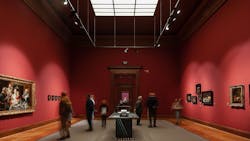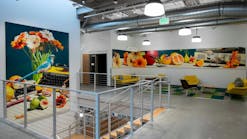Fagerhult: Supply chain back to normal, renovation market looks sweet
Fagerhult Group reported a 56% surge in fourth-quarter profit on a 25% sales jump, as CEO Bodil Sonesson declared that supply chain challenges have all but ended. She also gave a healthy LED lighting outlook fortified by a lively renovation market and by a pending European fluorescent ban.
“The positive trend with easing supply chain challenges has continued in the fourth quarter, and I would say the challenges are almost gone,” Sonesson told financial analysts on a web call yesterday to discuss quarterly and year-end results. The Habo, Sweden–based lighting company reported incipient supply chain improvements a quarter ago.
Sales for the fourth quarter ending Dec. 31 were 2.27 billion Swedish krona (SEK; US$218.3 million), up 24.8% from SEK 1.82 billion ($175 million) in the same quarter a year earlier. The increase was 16.7% when adjusted for currency exchange rates.
Net profit shot up to SEK 168.9 million ($16.2 million), from SEK 108.1 million ($10.4 million) in the fourth quarter of 2021. The increase was in part attributable to steady price increases by the company.
“We continue to see positive effects of the pricing management we’ve been working on all year,” Sonesson said. Chief financial officer Michael Wood added that the company expects to continue to raise prices this year.
For the year, sales for the year rose 16.7% (11% adjusted for currency) to SEK 8.27 billion ($794.7 million) from SEK 7.09 billion in 2021. What Wood referred to as the “rolling 12-month” performance prompted him to declare that “We now pick up where we left off before the COVID period began.” Back in 2019, the last full year before the financial full force of the pandemic, sales were SEK 7.84 billion. Net profit for 2022 rose 22.3% in 2022, to SEK 576 ($55.4 million) from SEK 469.6 million in 2021.
Renovation craze
Both Sonesson and Wood reiterated a theme they sounded after the third quarter: Sales will be driven by strong customer demand for renovations rather than new builds. Renovations and retrofits will happen as indoor and outdoor users re-emphasize energy efficiency amid volatile energy prices and carbon net zero goals, and as a September 2023 European ban on commercial fluorescent lighting approaches, they said.
“We see this happening quicker than we thought,” Sonesson said in response to an analyst’s question. “I’ve seen it increase incredibly in the last 18 months. It’s a trend that will impact us for a long time to come.”
In her opening remarks, she also noted that “in the lighting industry, this renovation demand is further driven by the ban of fluorescent lighting which is happening in September 2023.” The ban falls under the EU’s “Restriction of the use of Hazardous Substances” (RoHS) directive, aimed at eliminating mercury, a hazardous substance used in fluorescent lights. Like Fagerhult, Norwegian LED lighting supplier Glamox has also identified RoHS as a sales driver.
Sonesson noted that the emphasis among end users on energy efficiency should in principle also help drive sales of the company’s internet-connected lighting, because, according to her, connected lighting can increase total energy savings to 90% compared to conventional sources without advanced controls. Fagerhult offers the Organic Response brand of connectivity for indoor use and City Grid for outdoor, both of which it can add into the luminaire mix of the 12 different lighting companies that it operates.
But when quizzed by one analyst, she acknowledged that uptake among users of connected lighting — also known as IoT lighting — remains on the slow side, something she has also candidly stated in the past as have other vendors like Glamox.
“We see very positive developments, (but) it’s still in the early stages,” Sonesson said.
Getting smart at headquarters
One of those “positive developments” came during the last quarter, when Dutch e-commerce company Bol.com outfitted its Utrecht headquarters with around 6,000 Fagerhult brand luminaires that Fagerhult connected using Organic Response technology. The smart lights automatically adjust their brightness and on/off state as needed, and provide other smart building functions such as navigation, updates on room and desk availability, and energy usage reports.
LEDs Magazine will report more detail on Fagerhult’s IoT endeavors in a separate article.
Sonesson singled out other company highlights for the quarter (not IoT), including fine art spotlighting by iGuzzini at the Royal Museum for Fine Arts in Antwerp; platform lighting by Designplan Lighting at New Street Station in Birmingham, England; and bespoke interior lighting by ateljé Lyktan at the Clarion Hotel The Pier in Gothenburg, Sweden.
Highlight installations also included the Aman New York Hotel by iGuzzini; Charlotte Airport by WE-EF; the World of Volvo meeting place in Gothenburg by Fagerhult in a collaborative effort with other Fagerhult Group brands; Gatton prison in Queensland, Australia by Eagle Lighting and Designplan; Duisburg Hauptbahnhof railway station in Germany by Designplan; and others.
Fagerhult owns 12 lighting companies which it divides into four business areas. The Collection group focuses on design and includes Italy’s iGuzzini, Sweden’s ateljé Lyktan, Germany’s LED Linear and Germany’s WE-EF. Premium focuses on European customers and bespoke solutions via Sweden’s Fagerhult and Germany’s LTS brands. Professional provides indoor lighting in local markets and includes Australia’s Eagle, the U.K.’s Whitecroft, and Turkey’s Arlight; and Infrastructure is aimed at industrial and robust environments and includes the U.K.’s Designplan, Finland’s i-Valo, and the Netherlands’ Veko.
For the quarter, all four areas showed growth. Collection had the largest revenue with SEK 1.03 billion ($98.9 million), followed by Premium with SEK 781.3 million ($75 million), Infrastructure with SEK 279.5 million ($26.8 million) and Professional, with SEK 258.4 million ($24.8 million).
The Professional group, which had been underperforming, is now in “a more stable position,” Wood said.
CEO Sonesson cautioned, however, that markets in general are not stable in the tumultuous geopolitical environment, but said that “we are well positioned” and the company is “prepared for a longer period of uncertain times.”
*Currency converted via xe.com and current at time of publication.
This article has been updated since first publication.
MARK HALPER is a contributing editor for LEDs Magazine, and an energy, technology, and business journalist ([email protected]).
For up-to-the-minute LED and SSL updates, follow us on Twitter. You’ll find curated content and commentary, as well as information on industry events, webcasts, and surveys on our LinkedIn page and our Facebook page.

Mark Halper | Contributing Editor, LEDs Magazine, and Business/Energy/Technology Journalist
Mark Halper is a freelance business, technology, and science journalist who covers everything from media moguls to subatomic particles. Halper has written from locations around the world for TIME Magazine, Fortune, Forbes, the New York Times, the Financial Times, the Guardian, CBS, Wired, and many others. A US citizen living in Britain, he cut his journalism teeth cutting and pasting copy for an English-language daily newspaper in Mexico City. Halper has a BA in history from Cornell University.





